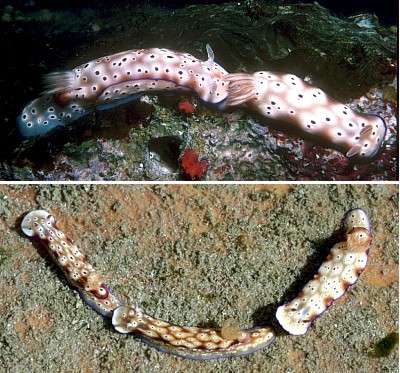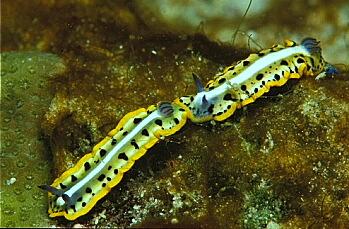

Trailing behaviour
PHOTO
Upper: Two Risbecia tryoni, Kwajalein Atoll. Photo: Scott Johnson. Centre: Three Risbecia tryoni, Enewetak Atoll. Photo: Scott Johnson. Lower: Chromodoris kempfi Bonaire, Netherlands Antilles, August 2002. Photo: Andreas Ahrens
Also known as queueing or tail-gating, all species of the chromodorid genus Risbecia exhibit this behaviour where they seem to play "follow the leader". Perhaps its a behaviour which has evolved amongst relatively uncommon animals to ensure they find each other for mating. When tailing, one animal appears to follow the mucous trail of the other until they actually make contact. Then the following animal, as can be seen in thse photos, keeps contact by touching the 'tail' of the leader. Sometimes 3 or 4 animals can be seen together.
I suggested years ago that this behaviour could be used as a distinguishing character for the genus Risbecia, but we now know that the Caribbean species 'Chromodoris' kempfi and the Indo-West Pacific species Hypselodoris paulinae also does the same thing.
Two messages om the Forum, one from Stuart Hutchison and the other from Mike Miller, report R. tryoni and the yellow-spotted Risbecia pulchella either trailing each other, or in close contact, suggesting that the chemical attractant driving this behaviour may be very similar in both species.
Other groups of opisthobranchs show similar behaviours, including aplysiids, aglajiids, and onchidorids.
See messages on the following pages for further photos of trailing:
• Risbecia ghardaqana
• Risbecia godeffroyana
• Risbecia imperialis
• Risbecia pulchella
• Risbecia tryoni
• Chelidonura varians
• Chelidonura inornata
• Chelidonura punctata
• Stylocheilus striatus
• Onchidoris bilamellata, message 2.
• Acanthodoris nanaimoensis
• Platydoris striata
• Phyllodesmium magnum, message 2
Authorship detailsRudman, W.B., 2003 (March 5) Trailing behaviour. [In] Sea Slug Forum. Australian Museum, Sydney. Available from http://www.seaslugforum.net/find/trailing
Related messages
Trailing/queueing or tail-gating
February 27, 2006
From: Dave Behrens
Hi Bill:
I was speaking to a rather large assemblange of Branch lovers at the Monterey Bay Aquarium this week when confronted with a question - new to me.
I had just shown examples of trailing when a guest asked if the real purpose of trailing was to save crawling energy for the tail-gaters by taking advantage of the slime trail laid down by the leader. Her analogy was drafting or slip-streaming in race cars and speed skaters. Certain pelicans and geese use this behavior to save energy inflight.
Terry Gosliner and I have always felt that this practise was simply to stay close to a potential mate. Even when the two or more individuals might represent different species (an example of the followers confusion).
Have you any thoughts on this, or know of any experimentation or research?
Thanks in advance.
Dave Behrens
dave@seachallengers.com
Behrens, D.W., 2006 (Feb 27) Trailing/queueing or tail-gating. [Message in] Sea Slug Forum. Australian Museum, Sydney. Available from http://www.seaslugforum.net/find/15945Dear Dave,
I must say I hadn't thought of saving energy - at the speed they go I don't think windresistance would enter the equation but I guess if you didn't have to produce your mucus trail as you crawled along, the would surely be an energy benefit. I guess you would have to first see if they can regulate the flow of mucus as they crawl along. Can they produce more when the going gets tough, and less when they can slide on someone else's trail.
I agree that I had always thought that following trails was a response the chemicals in the mucus - either a predator chasing down its prey or a 'suitor' chasing down a mate. There are quite a few references to trail following on the Navanax inermis Fact Sheet, but I don't know of any work in other opisthobranchs. It would be an interesting topic for a student to take up.
Best wishes,
Bill Rudman
